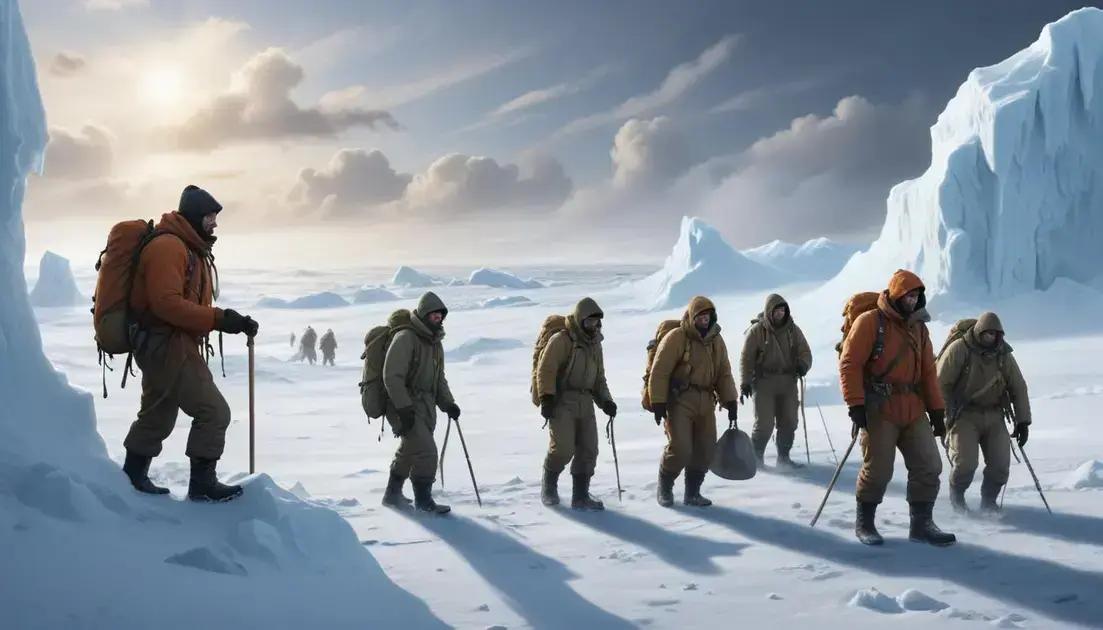
Race to the South Pole: Heroism and Tragedy on Ice
The South Pole expeditions led by Amundsen and Scott highlight key themes of heroism, preparation, and adaptability in exploration. Amundsen’s strategic planning helped him successfully reach the pole first, while Scott’s tragic story underscores the risks of underestimating nature. Their legacies continue to inspire modern exploration and emphasize the importance of teamwork and environmental respect in overcoming challenges.
At the heart of exploration lies the South Pole, where heroism and tragedy intertwine. Join us as we unravel the gripping stories of those who dared to conquer its icy expanse.
The Expeditions of Amundsen and Scott
The expeditions of Amundsen and Scott are among the most fascinating tales of bravery and tragedy in polar exploration. These two men embarked on a race to be the first to reach the South Pole. Roald Amundsen, a Norwegian explorer, focused intensely on planning and preparation. He had a deep respect for the harsh environment, which played a big part in his success.
Meanwhile, Robert Falcon Scott, a British naval officer, also aimed for the pole. Scott’s journey was marked by optimism and a sense of adventure. However, his team faced challenges like equipment issues and weather troubles. These factors ultimately led to their tragic end.
The story of Amundsen and Scott gives us insight into the human spirit and its will to explore. Their journeys teach us important lessons about respect for nature and the value of thorough preparation.
The South Pole was not just a destination; it was a testament to human endurance. Both explorers faced freezing temperatures, icy terrain, and the unknown. Their experiences remind us of the sacrifices made in the name of exploration.
Today, their legacies continue to inspire adventurers and explorers worldwide. The fierce competition and contrasting strategies of Amundsen and Scott remain a vivid part of polar history.
Heroism in the Face of Adversity
Heroism shines brightly during tough times. It’s in these moments that we see the true strength of the human spirit. Explorers like Amundsen and Scott faced extreme conditions in their quests. They battled freezing temperatures, fierce winds, and ice. Despite these hardships, their determination never wavered.
Amundsen’s team showed incredible teamwork and focus. They worked together to overcome obstacles and kept pushing forward. Their careful planning allowed them to navigate the harsh landscape more effectively.
On the other hand, Scott faced a different kind of adversity. Despite his optimism, his team struggled with supplies and poor weather conditions. Yet, Scott’s courage was evident as he remained committed to his goal, even in dire situations.
Both men made sacrifices for their dreams. These sacrifices highlight the courage needed in exploration. Heroism is not just about victory; it’s about facing challenges head-on and never giving up.
Today, we remember their bravery. Their stories inspire us to rise above our problems, showing that true heroism lies within each of us.
Lessons from the South Pole
The expeditions to the South Pole taught valuable lessons about exploration and humanity. One key lesson is the importance of preparation. Both Amundsen and Scott had different approaches. Amundsen planned every detail, keeping his team well-equipped. On the other hand, Scott’s less careful approach led to issues.
Another important lesson is adaptability. Amundsen showed how being flexible can lead to success. He changed his strategies based on the weather and conditions. Scott’s team, however, struggled to adjust when things went wrong, which hurt their chances.
Teamwork was also vital. Amundsen’s crew worked together smoothly. They had clear roles and supported one another. Scott’s team faced internal conflicts, which made it hard for them to succeed.
The harsh conditions of the South Pole remind us that nature should always be respected. Explorers learned that planning and being aware of the environment is essential. Both teams experienced setbacks, but they displayed incredible bravery and resilience.
These lessons go beyond exploration. They apply to everyday life, teaching us that growth often comes from facing tough challenges and learning from them.
The Impact of Climate on Exploration
The climate plays a huge role in exploration, especially in extreme areas like the South Pole. Weather conditions can make or break an expedition. Explorers faced freezing temperatures, strong winds, and heavy snowfall. These challenges tested their limits and changed their plans.
Amundsen understood the climate well. He used this knowledge to choose the right time for his journey. He picked a route that avoided the worst weather. This helped his team reach the South Pole first.
On the other hand, Scott underestimated the climate. His team encountered severe storms and struggled with polar conditions. These challenges added to their difficulties and ultimately contributed to their tragic fate.
Climate changes continue to affect modern exploration too. Today, researchers face melting ice and unpredictable weather patterns. This new reality brings fresh challenges for those venturing into polar regions.
Weather monitoring has become a key part of exploration. Modern explorers now rely on technology to track conditions before and during their adventures. Being adaptable and prepared is vital for success in any exploration effort.
Legacy of the South Pole Expeditions
The legacy of the South Pole expeditions is rich and meaningful. Both Amundsen and Scott left their marks on the world of exploration. Their journeys became a source of inspiration for future adventurers and scientists. These expeditions taught valuable lessons about endurance and teamwork.
Amundsen’s successful expedition showcased the importance of planning and preparation. His careful strategies inspired generations of explorers. He proved that understanding nature and respecting it can lead to success.
Scott’s story, though tragic, also carries a powerful message. It highlights the costs of ambition and the importance of adaptability. Scott’s example serves as a reminder to be prepared for the unexpected.
The expeditions sparked interest in polar research and exploration. They paved the way for scientific studies of Antarctica’s unique environment. Today, researchers continue to learn from these early journeys.
Amundsen and Scott’s legacies inspire modern explorers. As we push further into unknown territories, we remember their courage and dedication. Their stories shape our understanding of exploration and the natural world.
Conclusion
In conclusion, the stories of Amundsen and Scott remind us of the spirit of exploration. Their journeys to the South Pole taught us valuable lessons about preparation, teamwork, and adaptability. Both explorers, with their different approaches, faced extreme challenges, but their legacies live on.
Today, we continue to learn from their successes and failures. Their courage inspires new generations to explore and understand our world. As we venture into uncharted territories, we honor their contributions and carry their lessons forward.
Ultimately, exploring the unknown is about respect for nature and the courage to take risks. Let’s remember Amundsen and Scott as we seek our own adventures and discoveries.


